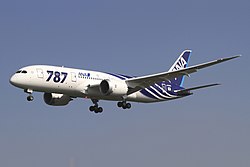 | |
 Interior of the Boeing Everett Factory in Everett, Washington, 2013 | |
| Company type | Division |
|---|---|
| Industry | Aviation |
| Founded | July 15, 1916 |
| Founder | William Boeing |
| Headquarters | , U.S. |
Area served | Worldwide |
Key people | Stephanie Pope (president and CEO) |
| Products | 737, 767, 777, 787 |
Production output | |
| Revenue | |
| Total assets | |
Number of employees | |
| Parent | The Boeing Company |
| Subsidiaries | Boeing Capital |
| Website | www |
| Footnotes /references Financials as of December 31,2024 [update] References: [1] [2] | |
Boeing Commercial Airplanes (BCA) is a division of the Boeing Company. It designs, assembles, markets, and sells commercial aircraft, including the 737, 767, 777, and 787, along with freighter and business jet variants of most. The division employs nearly 35,000 people, many working at the company's division headquarters in Renton, Washington, or at more than a dozen engineering, manufacturing, and assembly facilities, notably the Everett Factory and Renton Factory (both outside of Seattle), and the South Carolina Factory.
Contents
- Organization
- Management
- Products
- Model naming convention
- Aircraft in production or development
- Orders and deliveries
- Discontinued aircraft
- Gallery
- Specialty and other aircraft
- Concepts
- Airfoils
- Major facilities
- See also
- References
- External links
It includes the assets of the Douglas Aircraft division of the former McDonnell Douglas Corporation, which merged with Boeing in 1997. [3] As of the end of 2021, BCA employed about 35,926 people. [1]









